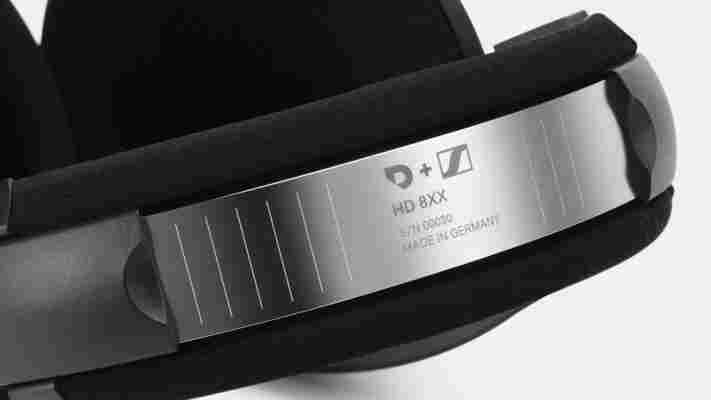For more than a decade, the Sennheiser HD800 have been the gold standard in reference-grade headphones. With outstanding clarity and a massive soundstage, they’re the go-to option for producers, performers, and audiophiles looking for the absolute best headphones money can buy.
But at $1,699 (£1,149, AU$1,899), they’re not exactly what we consider affordable.
The good news is, thanks to audio retailer Drop , you can practically get the same exact headphones with some minor tweaks for $1,100 instead.
Drop sent us a pair to test to see if we could spot any difference between the two and, dozens of audio tracks later, we really can’t.
Why are the Sennheiser HD800 so good?
Ask any audiophile about Sennheiser and they’ll list dozen-or-so reasons why the German audio manufacturer is so good. Mostly, however, it comes down to Sennheiser’s years of experience crafting audio products, the way the brand listens to user feedback, and its attention to detail.
The HD800 and its more modern successor, the HD800S, represent pretty much the pinnacle of Sennheiser’s efforts. Yes, you technically can buy more expensive headphones, but the HD800 have become the gold standard and benchmark for almost all other high-end headphones.
These open-back cans are built in such a way to allow you to critically evaluate music. They have a focus on the midrange and highs while still countering sibilance. There’s not an excruciating amount of bass - which might make them less appealing for some - but that allows the headphones to be nearly distortion-free at any volume.
Finally, they have a wide soundstage. This term has various interpretations and meanings depending on who you ask, but most consider it to be the ability for music to sound like it’s being played live and immerse the listener in such a way that they can hear where particular instruments are in the mix. It sounds a bit hokey, but it’s something that you can actually hear with the right sound equipment.
There’s no denying that they’re good headphones - but for their regular price, they were always just out of reach.

What’s the deal with Drop’s HD8XX model?
Enter the Drop + Sennheiser HD 8XX, a custom-built pair of headphones based on the HD800S. It’s one of several headphones that Drop and Sennheiser have collaborated on (there’s also an HD6XX model that we’re currently testing), which promises to chop down the price while still retaining all the qualities audiophiles love.
Several of the HD800S’s specs show up in the HD8XX, including the 4 Hz – 51,000 Hz frequency response and 0.02 % total harmonic distortion. The headphones also have a 300-ohm impedance, which means that you’ll need an amp of some sort to drive them as well.
The construction of the headphones remains great, and despite their large size, they fit comfortably on our ears for hours on end.
While they’re not exactly one-to-one replicas of the Sennheiser HD800 headphones (Drop says that it has changed the tuning slightly due to community feedback), by and large, you’re buying nearly the same headphones for a lot less.

Should these be your first high-end headphones?
At just over a grand, there’s going to be a lot of temptation to make these your very first pair of high-end headphones. While they're almost certainly going to be a big jump from what you’ve been listening to, here’s what you should know about headphones like these before you buy.
For one, headphones like these require an amp to drive - your phone or motherboard on your computer simply won’t be powerful enough to make them audible. Amps and DACs are sold in many different forms but, if you don’t have one, be prepared to drop at least another $200 on one to make sure you’re set up for success.
The other issue first-timers might have with the Drop + Sennheiser HD 8XX is that they’re open-back headphones - meaning they let a lot of sound in and a lot of sound out. Audiophiles don’t mind that because we’re typically squirreled away in our listening rooms away from any distractions, but other folks might want headphones that can be used when they’re out and about either on public transportation or in an office setting.
Finally, and this is a small caveat, these headphones don’t terminate in a standard 3.5mm cable - but rather a 6.35 mm (1/4") TRS single-ended plug. It’s the kind that you see electric guitars using and won’t fit into a standard audio jack. You can, of course, buy a cheap converter on sites like Amazon, but it won’t change the fact that you’ll still need a lot of power to drive them properly.
All that being said, we wouldn’t recommend these for your very first audiophile-grade headphones if you don’t know what you’re getting into. However, if these are your second pair and you’re ready to make the jump to some seriously high-fidelity music listening, then the Drop + Sennheiser HD 8XX is your discounted entry ticket.
What is gait analysis?
If you’re a runner, there’s a good chance you’ve encountered the term ‘gait analysis’ at some point in your training journey. When you have your shoes fitted properly in a specialist store, you usually have your gait analyzed to ensure that they won’t cause issues over time.
Depending on how you run, you may show overpronation, underpronation or neutral pronation. If your running shoes aren’t correctly fitted, then you might find that any misalignment issues are exacerbated over time as you train.
We spoke to a sport therapist, who broke down exactly what gait analysis is and outlined how you can use it to improve your running performance – either outside or on one of the best treadmills.

Gait is generally defined as a pattern of limb movements made during locomotion. In simpler terms, it’s the way a person walks or runs. Your gait is often affected by something called pronation, namely, the way your foot rolls upon landing, when your weight is transferred from the heel through to the forefoot. If you’re a runner, the degree to which your foot rolls on impact can have a big influence on your running style and success. This is because any overactive or underactive muscles in the feet can cause potential injuries and/or inefficiencies.
When it comes to pronation, there are three main types: overpronation, underpronation and neutral. All of these are natural and no one type is inherently better or worse than another.
Overpronation is where your foot rolls inward as you move, i the outer edge of your heel hits the ground first then your foot rolls, excessively, inward onto the arch. Overpronation forces excess wear on the inside of the foot, making it absorb shock less effectively. Over time, this is likely to impact the hips, knees and ankles, having a detrimental effect on a runner's form and increasing risk of injury. It’s thought that the vast majority of people overpronate, as this is almost certainly the most common type of pronation among runners.
Also known as supination, underpronation occurs when the outer side of your foot hits the ground at a relatively steep angle, causing your weight to roll onto the outer edges of your feet with hardly any movement inwards. This can be every bit as destabilizing as overpronation, as the jarring effect caused can send a significant amount of shock through the lower leg. In due course, a supinated foot’s inability to adequately absorb shock will affect a runner’s ability to perform well and stay injury-free.
Neutral pronation occurs when the foot lands on the outside of the heel before rolling inwards in an even and controlled manner. This form of pronation ensures body weight is distributed fairly evenly, thereby helping to absorb shock more effectively when your foot hits the ground. From a runner’s point of view, it is worth highlighting that neutral pronation carries less risk of injury than overpronation and underpronation. Of course, this doesn’t mean those running with a neutral gait are immune to injury.

So now we have a better idea of what gait analysis is, we need to get the lowdown on what’s actually involved. Jake Somers, a former rugby physiotherapist who now runs the UK’s All Sports Massage breaks it down.
“Gait analysis involves watching the client run in neutral shoes to see if there’s any movement in their ankle rolling in or out, and to assess the symmetry of the body as they run. The whole process only takes about 15 minutes, then the analyst will go over the findings with you.”
Once you’ve put on a pair of neutral shoes you’ll be asked to run on a treadmill, but only for about a minute or so. This will allow the analyst to watch how and where your feet are landing and to check for any biomechanical misalignments that may be present within your ankles or knees.
Once you’re done running, the analyst will provide detailed feedback. Some analysts may also record your run on video, enabling them to present an in-depth, frame-by-frame replay. After explaining the mechanics involved in how you run, the analyst will make recommendations for what type of shoe is likely to suit your own particular needs, taking into account your individual running goals and any previous injuries.
So where can you find this service? “Many decent sports shoe shops will provide a gait analysis assessment to assist you in buying the right running shoes,” Somers says.
It’s even possible to take advantage of virtual gait analysis, with companies like Running Bear providing comprehensive services online

So, taking all the aforementioned information onboard, what can a runner do to actually improve their gait? Somers sums it up succinctly: “To improve your gait the best thing you can do is get some properly fitting shoes that counteract the pronation and supination.”
The most prudent thing to do is to listen to your analyst and seriously consider investing in the shoes they end up recommending, as they’ll help provide the stability and support you’ve hitherto been lacking. And that’s not all, says Somers.
“To improve your gait further, get supportive insoles that stop pronation or supination.” Offering a deep heel cup and an arch that mimics the curves of your feet, supportive insoles help to provide firmness and durability, further improving your comfort and reducing the risk of injury.
It’s not all about shoes though. As vital as footwear is, it’s important to note the vital role that posture plays in the running process. Having a tall, straight posture with an ever-so-slight forward lean will keep you from overstriding and encourage your hips, glutes and back to function more fluidly. Also, try to visualize lifting your hips as you run. Maintaining this posture, especially when you start to feel tired, will – in conjunction with comfortable and supportive footwear – enable you to maximize the best aspects of your gait.
“The better your gait is, the more efficiently your body moves," Somers says. "Better efficiency means more energy to push you further. If your gait is bad then your body has to work harder to keep you going, meaning you fatigue faster. This extra stress wears out your joints and muscles quicker leading to various injuries.”
And one final word of caution for those runners just starting out: “It’s very important to make sure your gait is good before you take up running – because it can lead to lots of pain and discomfort otherwise.”
The inside story of the browser wars, told by a veteran
The story of Brendan Eich is in many ways the story of the evolution of the internet and the technologies we use to access it. It is also a story of battles won, lost and soon to play out.
Eich is best known as the creator of programming language JavaScript , which he developed over a sleepless period of ten days in 1995. At the time, he was working for Netscape, whose web browser dominated the market before Internet Explorer spoiled the party.
Recognizing that Netscape had lost its way, Eich spun out another project he had been working on, leading to the formation of the Mozilla Foundation. The organization went on to pioneer the concept of browser extensions with Firefox , which quickly became a household name, before it was crushed under the weight of Google Chrome .
Since departing Mozilla, Eich has focused his attention on a new company called Brave Software, which he believes will help usher in the next landmark period in the history of the internet.
Founded in 2015, Brave is the maker of a privacy-centric web browser by the same name, which blocks both ads and tracking cookies. It is also the proving ground for a novel opt-in advertising model, whereby users are paid for their attention.
With these building blocks, Eich is aiming to bring to fruition an internet characterized not by monopoly and unfettered surveillance, but rather decentralization, disintermediation and individual privacy .

JavaScript is born
Today, JavaScript is deployed across practically all websites, as part of a famous trifecta that also includes HTML and CSS. It allows web developers to code in all the rich features and dynamic content users interact with on the web, and can also be deployed server -side and for various other purposes.
Given its ubiquity and the extent of its influence over the web , it’s easy to forget JavaScript is the creation of a single person, who put it together in under a fortnight. “The web was evolving almost in a biological fashion [in the 1990s],” Eich told TechRadar Pro . “My big contribution to the process was JavaScript.”
When Eich joined Netscape in 1995, he says there was a “feeling of doom” hanging over the company, because Microsoft was breathing down its neck. The infamous Microsoft strategy was to “embrace, extend and extinguish”; it would embrace a new type of software, extend it with proprietary facilities that only functioned inside Windows, and harness these new capabilities to extinguish the competition.
The previous year, Netscape had spurned a low-ball acquisition offer from Microsoft, so the company knew it was next in line for the typical treatment. The plan to shield itself relied heavily on the integration of Java into the browser and the opportunities made possible by JavaScript, which was designed as a dynamic companion language that non-expert developers could use to add interactivity to their websites .

“We knew Microsoft was coming after us and we wanted to get Netscape Navigator 2.0 out the door, with Java as the big programming language and JavaScript as the sidekick that let the average scripter glue things together,” Eich explained.
To some extent, the endeavor was a success. Microsoft, which had previously stated its intentions to make VBScript the go-to language for building web applications, was ultimately forced to build support for JavaScript into Internet Explorer. This meant the company did not have control over the favorite scripting language of the web.
Until 1996, Eich was the sole developer working full-time on the JavaScript engine, which was plagued by technical debt (in other words, messy code) that resulted from the speed with which it was first composed. It was also apparent that a specification needed to be created, to guarantee web pages would function as intended across the multiple browsers that now supported JavaScript.
After rewriting the core, Eich helped build out a vendor-neutral specification in collaboration with Microsoft and other players, which was then left under the stewardship of a standards body called Ecma International.
History shows that Netscape was ultimately unsuccessful in fending off the advances of Microsoft, which eventually captured 95% of the browser market with Internet Explorer. Bill Gates had not only made his browser free, but also packaged it with Windows machines, which left Netscape no room to maneuver.
“A bunch of us started to see the writing was on the wall,” said Eich. “The feeling that we were doomed had been fulfilled, and the question became: what next?”

Mozilla breaks free
Knowing itself beaten, Netscape decided to open source its browser code. Eich says the idea was to create a community like the one that surrounded Linux , which would engender new browser innovation.
The company tasked Eich and a group of other developers with setting in motion the project, which came to be called Mozilla. The team worked “inside a fishbowl” at Netscape, at a remove from the rest of the company, Eich explained.
In the coming years, however, the relationship between the Mozilla team and Netscape executives soured. The two groups traded blows over product design, release timelines, the toxic working culture and other topics.
“It was a difficult time,” said Eich. “I stopped using my Netscape email as much as I could and used an ISP email instead. I acted as if I were completely outside the firewall .”
“I also acted as a proxy for the developers we were trying to bring in, who didn’t have the advantage of being employees. Meanwhile, Netscape kept regressing to the mean when it came to the strength of its programmers.”
After a series of layoffs in 2003, Eich and the Mozilla team broke out of their fishbowl to form a standalone non-profit called the Mozilla Foundation, which was tasked with carrying the project forward.
Meanwhile, wounded by the famous antitrust ruling over the bundling of Windows and Internet Explorer, Microsoft had grown lazy with its web browser. The strength of the company’s grip on the market meant it no longer had reason to innovate, creating a window of opportunity for a plucky newcomer.
Despite the politicking inside Netscape, the Mozilla team had managed to build a browser capable of rising to this challenge. The first ever to support extensibility, Firefox (as it came to be known after a series of name changes) rose quickly to prominence and reignited competition in the browser space, says Eich.
Mozilla reaped the rewards of its tenacity in the years that followed, attracting many millions of users to Firefox and netting a lucrative deal that saw Google become the browser’s default search engine. Ultimately, though, this level of momentum proved unsustainable and Mozilla was caught out by developments elsewhere in the technology world.
The rise of the smartphone in the late aughts transformed the way people engaged with the internet, and Mozilla failed to spot the danger. While the iPhone shipped with Safari pre-installed and Android devices came with Chrome, Firefox was left out in the cold. Once again, Eich found himself on the wrong end of the platform effect.
Locked out of the mobile market and unable to compete with Google’s marketing spend, Mozilla could do little to stop the numbers tumbling. Once responsible for roughly 30% of web activity, Firefox now holds just a 4% market share, the latest figures suggest.
Although there were efforts to limit the damage with Firefox OS and other projects, Mozilla never managed to regain a proper foothold and has now pivoted towards other products, including a new VPN .
Eich eventually left the organization under a cloud of controversy in 2014. After less than two weeks as CEO, it emerged he had made a donation in support of a ban on same-sex marriage, and the backlash was fierce. We were told an NDA signed between Eich and Mozilla precluded discussions of this chapter of his life.
Brave new world
While no rational person would dispute the importance of Eich’s contribution to the web, it is also true that he has been on the losing side of both so-called browser wars; first at Netscape, then at Mozilla.
This is a pattern he is hoping to break with Brave, which is pitched as the antidote to the threats posed by Google and its stranglehold on the browser and search markets.
Brave’s browser blocks all advertising by default and has a no-tolerance policy towards third-party cookies, which track users across the web to help inform highly-targeted advertising efforts.
Although there are now plenty of browsers that block invasive tracking techniques, Brave stands apart for its ambitions to rewire the economics that underpin the digital advertising industry.
“The plan was that Brave would be faster, easier on the battery and more private,” said Eich. “And with the help of blockchain technology, we also wanted to replumb the economic engine [of the web].”
The company’s unusual model is built around its Basic Attention Token (BAT), which was launched in 2017 via an initial coin offering (ICO). When an advertiser signs up for a campaign, Brave uses 70% of the fee to purchase BAT from the open market, and these tokens are then distributed to users who have opted-in to the ads program.
Once in the user’s possession, BAT tokens can either be donated to favorite content creators, used for microtransactions with Brave partners, or flipped into regular currency via an exchange.
Which specific ads are served to which specific users is determined by browsing data that is stored on-device and run through a machine learning (ML) model. Apparently, this approach actually yields markedly higher clickthrough rates than the 2% industry average.
Unlike the Google system, which is based on tracking users indiscriminately across the web, the Brave model is opt-in only, compensates the user for their participation and does not involve the transport of browsing data to the cloud .
The signs suggest this strategy is paying off for Brave, which has benefited from increasing awareness of the importance of privacy among consumers. The latest figures show the browser now attracts 50 million monthly users, which is double the figure from a year ago, and quadruple the year before that.
While these numbers are modest in the context of the total volume of web users, Eich predicts that enthusiasm for the service among developers, crypto fans and privacy evangelists is bound to spill over.
“There are privacy nihilists out there that we’ll never convince, but people have generally become more conscious about their privacy as a result of security breaches and events like the Cambridge Analytica scandal,” he said.
“But to breach the chasm to mass market, reaching people who are aware of these kinds of problems matters, because they convert their friends and family, and this creates rolling thunder.”
Empire building
Over the last couple of years, Brave has quietly set about expanding its empire with new privacy-centric products. Orbiting its browser, there is now a Brave VPN, firewall, encrypted video conferencing service, crypto wallet, news aggregator and search engine.
Asked which areas Brave will look to expand into next, Eich declined to provide any concrete information, but did concede the company is “looking at the larger space”. We wouldn’t be surprised to see an encrypted email service from Brave in the near future, for example.
All of these technologies will be foundational to Web 3.0, a new generation of the internet defined by decentralization, disintermediation and greater user privacy. Among those attempting to bring Web 3.0 into being, many believe blockchain and cryptocurrency will play a fundamental role in the transition.
Naturally, Brave has attracted a large number of cryptocurrency enthusiasts, whose ambitions with regards to economic freedom align closely with the company’s attempts to create a more equitable and private web.
The long-term success of the project, however, will be determined by how effectively Brave is able to sell itself to a wider and less technical audience. It has a lot of ground to make up before it can hope to challenge the dominance of Google and other incumbents.
However, as Eich’s story demonstrates, the internet is littered with the corpses of fallen giants. The cry for greater privacy on the web is growing louder and louder, and Brave has put itself in a position to ride the zeitgeist.